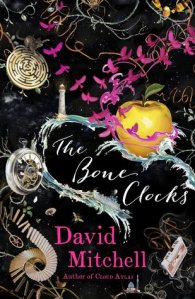 Hoo boy. I said 2014 would be my Year of Big Books and this is most definitely a Big Book in all senses of the word. It is close to 600 pages in hardback with fairly small print, so it’s literally big. It covers a span of over fifty years and many characters, so it’s figuratively also big. And it’s not actually published until September 2nd 2014, so the fact that I have been able to read an advance copy is frankly HUGE.
Hoo boy. I said 2014 would be my Year of Big Books and this is most definitely a Big Book in all senses of the word. It is close to 600 pages in hardback with fairly small print, so it’s literally big. It covers a span of over fifty years and many characters, so it’s figuratively also big. And it’s not actually published until September 2nd 2014, so the fact that I have been able to read an advance copy is frankly HUGE.
The proof copy I have just finished expressly states that it is not for quotation, but the jacket copy is not included in that, so here we are:
“The Bone Clocks follows the twists and turns of Holly’s life from a scarred adolescence in Gravesend to old age on Ireland’s Atlantic coast as Europe’s oil supply dries up – a life not so far out of the ordinary, yet punctuated by flashes of precognition, visits from people who emerge from thin air and brief lapses in the laws of reality. For Holly Sykes – daughter, sister, mother, guardian – is also an unwitting player in a murderous feud played out in the shadows and margins of our world, and may prove to be its decisive weapon.”
I won’t lie. When I read that description, I was a little, um, apprehensive. See, David Mitchell blew my mind with Cloud Atlas and I absolutely loved loved loved Black Swan Green. But then along came The Thousand Autumns of Jacob de Zoet and I was crushed. I found it unreadable and gladly jettisoned it after 50 pages. But with The Bone Clocks, I think it’s safe to say it is an epic and triumphant return to form. The book opens in 1984, with Holly Sykes deciding to run away from home after an argument with her mother. Headstrong and furious she refuses to give in and go home, and thus she encounters a strange woman who offers a small kindness in exchange for ‘asylum’. Decades will pass before Holly fully understands exactly what that flip little moment has got her into.
After the opening, narrated by Holly, each section of the book moves forward in time and has a different narrator, as Holly becomes a supporting player in her own huge story. That is until the final section, Holly once again is our narrator, a stylistic echo of Cloud Atlas, if ever there was one. I can’t quite say enough good things about this insanely inventive, daring, bravura novel. The wheels could very easily have come off, as Mitchell spends almost two thirds of the novel keeping that murderous feud in the shadows, drip feeding little bits of information to the reader, enough to make you think “what the actual fuck” and compel you onward at the same time. It’s a fine balancing act, one which Mitchell pulls off masterfully. It’s nearly 400 pages in before the murderous feud is brought front and centre and fully explained and even then, it’s done so in a way which bamboozles as much as it enlightens. I mean that as a compliment.
The final chapter suggests a future not unlike the post-electric wasteland Anne Washburn imagines in Mr Burns, only even bleaker and with more violence. It’s always risky when authors take on the near future but Mitchell is far more successful than Jennifer Egan was in A Visit From The Goon Squad, which I enjoyed right up until that final fateful awful chapter. Similarly, The Teleportation Accident went that one step too far. I suspect Mitchell won’t come out of the reviews unscathed for his ideas of how technology will progress before collapsing in on itself, but I went with it. His writing is just so glorious (I wish I could quote any number of choice passages, but you’ll just have to read the book and find out how gorgeous it is) and the characters so brilliant, vivid and real (Hugo Lamb, making a return appearance after one chapter in Black Swan Green, is especially magnificent), that by the time you get to the final chapter, you’ll believe anything Mitchell tells you and be willing for some kind of light in the darkness to emerge. Whether it does or not, I couldn’t possibly say, but I implore you to read this book.